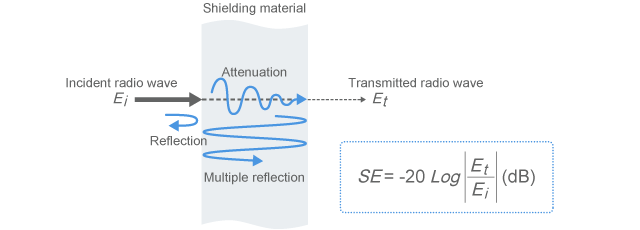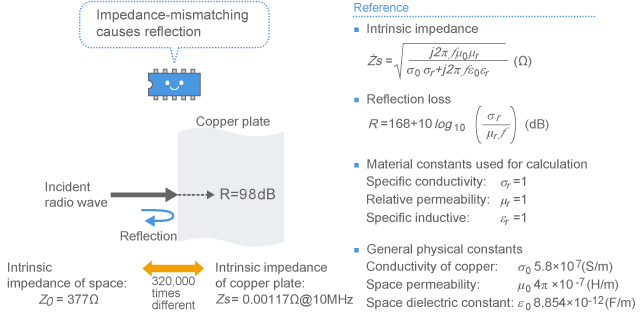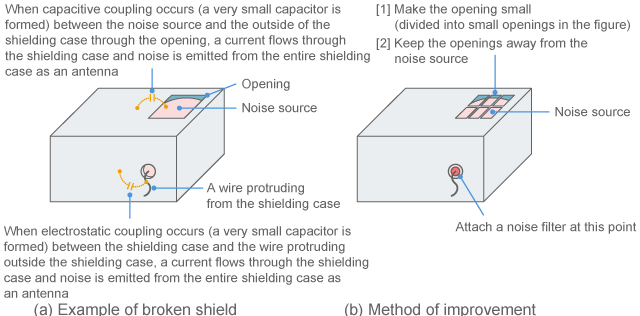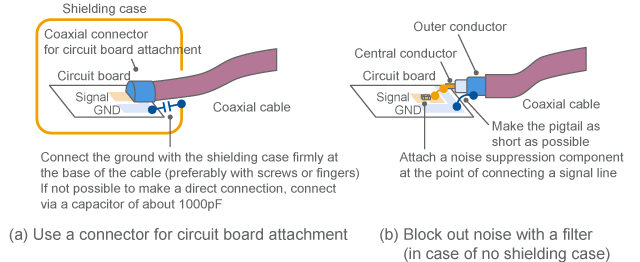4-4. Noise shield
Section 4-2-1 described that a shield is used to block out the spatial noise conduction. In many cases, this shield works as an electromagnetic shield. This section describes general characteristics of electromagnetic shield and explains several points to be kept in mind for effective use.
4-4-1. Shield configuration
(1) Shield of electronic devices
Shields used for electronic devices are implemented in a way to cover up the body, circuit board or cable as shown in the figure below. This section will focus on the sections where noise penetrates those shields as shown in the figure and describe the effects of the electromagnetic shields to block out radio waves based primarily on the material characteristics.
Shields are not only used for noise emitting to the outside but also used for external noise entering into the circuit. Just like the case of antenna, since these two effects are the same, the section will only focus on the noise emission.
Fig. 4-4-1 Example of shield configuration for electronic devices
(2) Breakdown of shielding effect
As shown in Fig. 4-4-1, the effect from confining noise with a shield can be generally explained by using the Schelkunoff's formula.
As shown in 4-2-2, the shielding effect for radio waves hitting the shield from the left side and leaking out to the right side is considered. Here, we assume that the radio waves leaking out to the right side are weaker than the radio waves hitting from the left side by SE (dB). The Schelkunoff's formula expresses the shielding effect SE by summing three terms as below.
(Formula 4-4-1)
-
R
Loss of radio waves by reflection at the surface (reflection loss)
-
A
Loss of radio waves by attenuation inside the shield (attenuation loss)
-
B
Effect of multiple reflection between the front side and back side (multiple reflection effect)

Fig. 4-4-2 Shielding effect
Of these, the multiple reflection effect B is ignored here, since it has only small influence except under a special condition of very small absorption loss of A.
Although the Schelkunoff's formula is an approximation formula, it has practically sufficient accuracy and is widely used because it is useful for understanding the shielding effect. Please refer to technical books [Reference 3]
for details. This section will further describe the general shield properties based on this formula.
4-4-2. Shield properties
(1) Shielding effect of about 100dB with a very thin plate as long as it is made of metal
Fig. 4-4-3 shows a case of copper plate as an example of calculation results that use the Schelkunoff's formula.
Fig. 4-4-3 Shielding effect of copper plate
Fig. 4-4-3(a) represents the frequency characteristics with a thickness of 0.1mm. The shielding effect SE indicated by a red line reaches 100dB or more in the entire range from 0.1 to 1000MHz. In case of noise suppression for general electronic devices, 100dB is considered to have a sufficiently large effect.
Fig. 4-4-3(b) shows calculation results by changing the thickness with a fixed frequency of 10MHz. Even a very thin copper plate of 10
µ
m thickness can have a substantial shielding effect. The breakdown of the effect is explained below.
(2) Reflection loss
The blue line in Fig. 4-4-3 represents the reflection loss R. It is understood from the figure that copper has an effect of nearly 100dB solely from the reflection loss.
The reflection loss occurs due to very bad impedance matching between the intrinsic impedance of space and the intrinsic impedance of shielding material when radio waves are transmitted from the left to the right as shown in Fig. 4-4-4. The intrinsic impedance of space is 377 ohms, while the intrinsic impedance of copper plate is only 1.17 milliohms at 10MHz. The difference is indeed 320,000 times. Therefore, the energy of the radio waves can hardly enter into the copper plate.
The intrinsic impedance here represents the property of radio waves transmitting as plane waves inside a specific material and indicates the amount equivalent to the characteristic impedance of the transmission line. It represents the ratio of the electric field to the magnetic field and is a value determent by the dielectric constant
ε
, magnetic permeability
µ
, conductivity
σ
and frequency
ƒ
, etc.
Generally, since metals have an extremely high conductivity, the intrinsic impedance becomes very small.
Although Fig. 4-4-3 shows the case of copper, iron has a conductivity one order smaller and a magnetic permeability 1000 times higher. So the reflection loss is more or less smaller. However, it still has a reflection loss of nearly 60dB at 10MHz. Therefore, most metal materials are considered to be able to achieve a reflection loss that causes no practical problems. This reflection loss can be achieved regardless of the thickness. (If the thickness is extremely thin, a correction for the multiple reflection effect is required)
Since the reflection is caused by the conductivity, it also means that the shielding effect can be reduced at a section where the resistance is high (if any). For example, in case that there is a joint in the shielding plate, any resistance at the connected section can significantly reduce the shielding effect. In order to ensure the conduction of connected section, a conductive gasket etc. may be used.

Fig. 4-4-4 Reflection of radio wave at the surface of shielding plate
(3) Attenuation loss
The green line in Fig. 4-4-3 represents the attenuation loss. This loss tends to sharply increase as the frequency and/or material thickness increase(s). Therefore, in case of Fig. 4-4-3(a) for example, the attenuation loss exceeds the reflection loss in the frequency range of 100MHz or more, achieving an extremely large shielding effect of 200dB or more in total.
Fig. 4-4-5 Attenuation of radio wave inside the shielding plate
The attenuation loss is an attenuation of radio waves due to a property generally known as the skin effect. When radio waves enter into a metal, the radio waves are characteristically attenuated by a factor of 0.37 at the skin depth of
δ
from the surface. Therefore, if the shielding plate is thicker than the skin depth, a significant effect can be expected.
When using shielding materials with the same thickness, the material with a thinner skin depth is considered to have a better attenuation loss. Fig. 4-4-6 shows calculation results of skin depths for general shielding materials (copper, aluminum and iron). The higher the frequency, the thinner the skin depth becomes, and thus the attenuation loss can be expected. At 10MHz, the attenuation loss can be expected from copper with a thickness of 20
µ
m or more and from iron with a thickness of 2
µ
m or more.
The skin depth also varies depending on the magnetic permeability
µ
and conductivity
σ
of the material. The higher the conductivity or magnetic permeability, the thinner the skin depth becomes. Although Fig. 4-4-6 indicates that iron has a lower conductivity than copper, iron has a skin depth one order thinner than copper due to its overwhelmingly large magnetic permeability. Therefore, it is understood that iron is a material with a large attenuation loss even though its reflection loss is smaller than copper. (Since Fig. 4-4-6 assumes that the relative permeability of iron is 1000, it is not quite accurate)
Fig. 4-4-6 Skin depth of metal plate
(4) Material parameters that affect the shielding effect
When a metal plate is used as above, a larger effect can be gained by:
-
(i)
using a thicker shielding material (the attenuation loss increases)
-
(ii)
increasing the conductivity (both attenuation loss and reflection loss increase)
-
(iii)
increasing the magnetic permeability (the attenuation loss increases)
Usually, as long as it is a metal plate, any materials or thickness can exert practically sufficient shielding effect. However, if you are dealing with a frequency range of 100kHz or lower in the vicinity of a loop antenna as described below, the material and thickness may be important.
4-4-3. Shield of low frequency magnetic field
As shown in the calculation results of Fig. 4-4-6, the skin depth increases as the frequency decreases. Therefore, when using a thin metal plate of about 0.1mm thickness, a large attenuation loss cannot be expected from copper or aluminum in the range of 1MHz or lower and from iron in the range of 10kHz or lower. Shielding such low frequency noise with the attenuation loss requires a substantially thick material.
As mentioned in the previous section, we are supposed to be able to expect sufficiently large shielding effect from the reflection loss in normal cases even without the attenuation loss. However, this is on the premise that the intrinsic impedance of material is extremely smaller than the intrinsic impedance of space.
In fact, when the shielding material is placed in the vicinity of a noise antenna, the wave impedance (ratio of the electric field to the magnetic field) is different from the intrinsic impedance of space (377 ohms). Please refer to Section 4-4-2 for the wave impedance in the vicinity of an antenna. The reflection loss of the shielding material placed in the vicinity of an antenna varies depending on this wave impedance.
Particularly in the case of Fig. 4-4-7, the magnetic field is strong in the vicinity of loop antenna, making the wave impedance way less than 377 ohms. Therefore, the impedance-mismatching with the intrinsic impedance of the shielding material is reduced, and thus reducing the reflection loss. Therefore, the attenuation loss needs to be increased for compensating the reduction. However, since the skin depth increases in the low frequency range, a fairly thick material needs to be used.
For the above reason, it is hard to shield low frequency noise in the vicinity of loop antenna by using a good conductor such as copper. In such a case, an iron plate (thinner skin depth) is more suitable than a copper plate. In addition, a magnetic shielding technique may be required apart from the electromagnetic shield.
Fig. 4-4-7 Difficult to shield low frequency magnetic field
4-4-4. Connection of shielding case
As explained above, the shielding effect of a material can be estimated by the Schelkunoff's formula. However, when it is applied to actual electronic devices, you are usually not able to gain the effect as described here. The primary reason is that any connected section or opening may become a bottleneck and somehow interfere with getting sufficient material performance. This section explains several points to be kept in mind for connecting a shielding case.
(1) When assembling a shielding case
As described above, the shielding effect of a metal plate is primarily generated by the conductivity. That is to say, it is important that the current can easily flow through the shield surface. If there is an opening or gap in the shield surface, it is hard for the current to flow through, and thus impairing the shielding effect.
As shown in Fig. 4-4-8, the connected section of a shielding case should be firmly attached. A good shielding can be maintained by seamlessly connecting the shield surfaces with use of conductive gaskets etc. If you are only using screws or contact points for making connections, the interval between screws or contact points should be reduced (to about 1/20 of wavelength).
If there is still a gap in the shielding case as shown in Fig. 4-4-9, you need to be aware that radio waves are likely to be emitted particularly at the frequency that makes the gap length form 1/2 wavelength. (For example, in the case of 12cm CD slot, it will be approx. 1.2GHz.)
Fig. 4-4-8 Connection of shielding case

Fig 4-4-9 Effect of a slit opening
(2) Factors other than radio wave shield
If the shield is broken due to an opening in the shield, incomplete enclosure of the entire object, or a wire protruding from the shield, the shielding case itself becomes an antenna and emits radio waves. In this situation, you may say that the common mode noise has been induced to the shield.
This phenomenon is different from the problem where the opening shown in Fig. 4-4-9 works as an antenna. The entire shielding case or the entire system works as an antenna as shown in Fig. 4-4-10(a). Since the antenna becomes a large size, the frequency of the nose emitted will be lower that the frequency estimated from the size of the opening.
The energy is not so high, since it is driven by floating electrostatic capacitance etc as described in Fig. 4-4-10(a). However, you need to be aware of this possibility if a complete shielding is required.
As described in Fig. 4-4-10(b), in order to prevent this from happening, you need to:
-
(i)
insert a filter if a wire is protruding
-
(ii)
reduce the size of opening if the opening is the cause of problem, or keep the internal noise source away from the opening
-
(iii)
increase the enclosure if the entire object has not been enclosed.
These methods are also effective for ground enforcement

Fig 4-4-10 Improvement for sections with broken shield
4-4-5. Connection of shielded cable
(1) Ground of shielded cable
Although you may say that the primary function of shielding case is "confining the noise inside", the shielding part of a shielded cable may also work as a path for current. Therefore, extra care needs to be taken for the section where the shield is connected to the ground.
An example of the shielding part that works as a path for current is a coaxial cable shown in Fig. 4-4-11. As you know, a coaxial cable can be used as a shielded cable. It is also an ideal transmission line. The outer conductor (outer sheath) is a return circuit of signal current.
In terms of shield connection to the ground, the same concept is applicable to general shielded cables other than coaxial cables. Although the return circuit of current and the shield may be clearly separated in some cases, the common concept can be applied to the noise suppression for general electronic devices.
Therefore, this section explains the shield connection with reference to coaxial cable as an example.

Fig. 4-4-11 Coaxial cable
To transmit a signal through a coaxial cable, the outer sheath should be connected to the circuit ground as shown in Fig. 4-4-11(b). This allows cancelling out the electromagnetic field caused by the current flowing through the inner conductor with the current flowing through the outer conductor, eliminating the noise emission from the cable.
For a general shielded cable, the shielded cable should be connected to the ground at both ends. However, for an electrostatic shield, only one end may be connected in some cases.
(2) Connection to shielding case
How should we connect the shield of this cable to the shielding case? Fig. 4-4-12 shows a schematic diagram that connects two shielding cases with each other.
As shown in Fig. 4-4-12, in order to achieve the complete shield connection, the entire circumference of the outer sheath of the shielded cable needs to be connected to the shielding case. For this purpose, shielded connectors are usually used.
If both shielding cases have been connected to the earth ground separately, it might cause a ground loop or it might not be able to comply with the principle of single point ground as shown in Fig. 4-4-12. These facts go against the general design policies for eliminating noise interferences in a relatively low frequency range. That is to say, pursuing the shield for eliminating noise emission could actually lead to increase low frequency noise.
As described above, noise suppression may have a trade-off relationship depending on the status of ground connection, and there is still a possibility of not being able to avoid handling noise case by case. (For example, if the earth ground is disconnected on one side in Fig. 4-4-12, the above problem is resolved, while it could increase the risk of electrification or could compromise the susceptibility to static electricity)
Fig. 4-4-12 Connection to shielding case
(3) Connection to circuit board
Although there are problems as explained above, the ground of a shielded cable is in general firmly connected to the shielding cases on both ends as shown in Fig. 4-4-12 and is then connected to the circuit ground. This allows:
-
(i)
providing a shield structure integrated with the shielding cases against noise, and
-
(ii)
providing a correct current feedback circuit for the signal.
Fig. 4-4-13 shows the connection to a circuit board with reference to coaxial cable as an example.
Fig. 4-4-13(a) shows a case of connecting a wire to a circuit board. The shielding outer sheath of the cable is connected to the shielding case by a coaxial connector. This allows making a correct shield structure.
Fig. 4-4-13(b) shows that a gap between the coaxial connector and circuit board is also connected by a short coaxial cable. In this case, you can create an even better circuit for the signal transmission. Please note that the ground of the coaxial cable should also be connected on the circuit board side.
Fig. 4-4-13 Ground of shielded cable
4-4-6. Example of inappropriate shield
(1) Pigtail
As an example of incorrect ground connection for shielded cable, there is a structure called "pigtail". This is a method of connecting the shielding outer sheath to the ground by bundling it like a wire as shown in Fig. 4-4-14(a). It is easy to make connection. But the bundled part generates impedance and impairs the shielding effect.
Fig. 4-4-14(b) shows an example of pigtail connected to the shielding case. In this case, the connection destination is appropriate for shielding noise. However, the shielding effect has been impaired by the pigtail. In addition, there is no return path for the signal current (the figure shows that the current returns through the ground of shielding case that is relatively far away). In such a case, noise may be induced to the ground by the signal current, and thus the shielded cable can work as an antenna for this noise.
Fig. 4-4-14(c) shows an example of pigtail connected to the circuit ground side. In this case, the return path of the signal current is appropriate. However, the the shielding case and the ground of the shielded cable have been separated from each other. Therefore, the shielding effect is significantly impaired.
Fig. 4-4-14 Example of inappropriate ground
(2) How to improve pigtail
Actually, the connection shown in Fig. 4-4-14(c) is inevitably performed as a general method when there is no shielding case or when it cannot be connected to the shielding case due to the principle of single point ground. Although it is not recommended in case you need to substantially eliminate noise, Fig. 4-4-15 shows a method to improve this situation.
Fig. 4-4-15(a) is a case that the signal is substantially shielded. A dedicated connector is used for the connection between the circuit board and coaxial cable. If the ground of this circuit board is stable, the function of the cable shield will be relatively efficient.
In order to stabilize the ground of the circuit board, the circuit ground should be connected to the shielding case (if any) at the base of the cable (nearest possible) as shown in the figure. If you cannot make connection due to the design policy of single point ground, it should be connected via a capacitor as shown in the figure.
Fig. 4-4-15(b) is an example of noise suppression with an EMI suppression filter. Since the shield has been broken at the part exposed from the shielded cable, a filter is attached at this point to block out noise going in and out. Although the figure shows a coaxial cable, a common mode choke coil is used for this part in case of differential signal.

Fig. 4-4-15 Example of improving the ground
(3) Broken shield
If the shielding outer sheath of a shielded cable is broken, what effects may be caused? For example, if there is a fissure in the circumferential direction as shown in Fig. 4-4-16(a), it would cause a serious impact if it goes through the entire circumference even if it is a very small gap. This is because the shield current that is flowing in the length direction is interfered. Even if it is just a single fissure, the effect of the entire cable is impaired.
If there is a fissure in the longitudinal direction as shown in Fig. 4-4-16(b), it would not interfere with the shield current, causing a relatively less impact.
Fig. 4-4-16 Example of fissure in shielded cable
“4-4. Noise shield” - Key points
-
Shielding effect is formed by the reflection loss and attenuation loss
-
In most cases, it has a sufficient effect with a thin metal plate
-
The shield of shielded cable should be connected to the shielding case all along the circumference